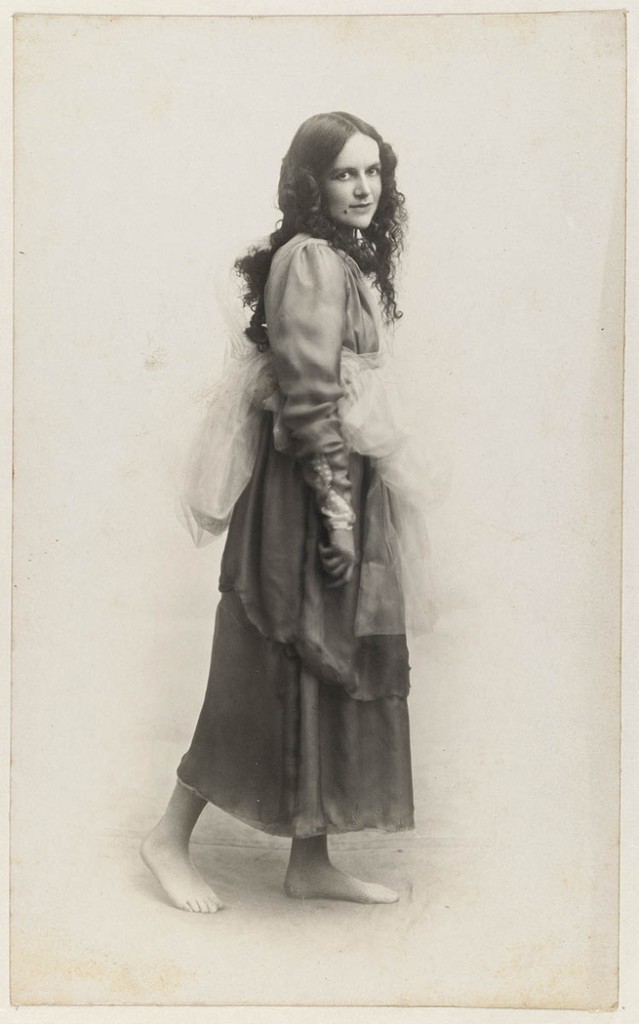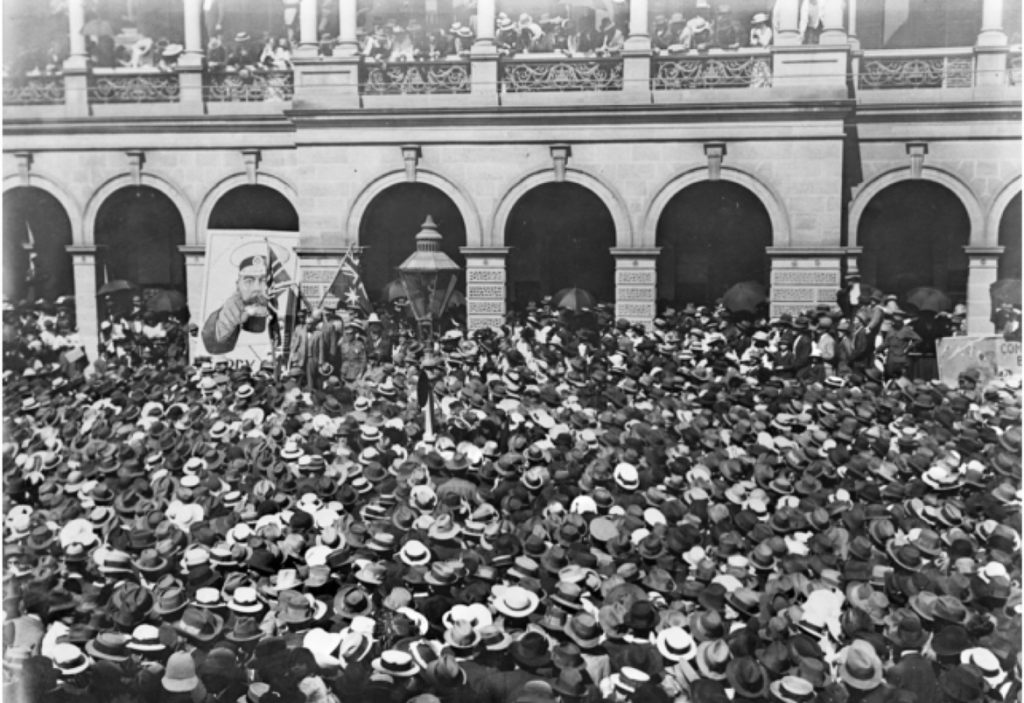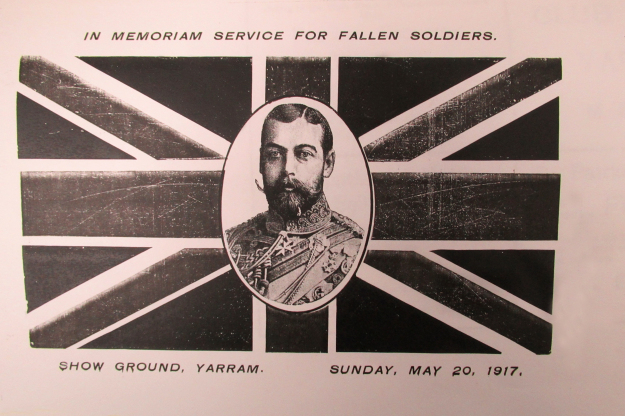‘Divided sunburnt country: Australia 1916-18: a new series from Honest History’, Honest History, 7 June 2016 updated
 Dorothea Mackellar in theatrical costume, 1918 (Wikimedia Commons/SLNSW)
Dorothea Mackellar in theatrical costume, 1918 (Wikimedia Commons/SLNSW)
In 1904, Dorothea Mackellar, then aged 19, wrote her poem ‘My country’, which included these famous lines:
I love a sunburnt country,
A land of sweeping plains,
Of ragged mountain ranges,
Of droughts and flooding rains.[1]
Ten years later, Dorothea’s sunburnt country was at war. Australian stories of that war, particularly during these centenary years, have tended to stress daring deeds and heroic deaths. This Honest History series, ‘Divided sunburnt country: Australia 1916-18’, takes a different tack. We are using the series to explore a crucial question: whether what happened at home in Australia during the Great War was actually more important than what happened overseas on battlefields. More important in the effect it had on Australia, on individuals, on families, on social structures.
This suggestion challenges the dominant interpretation of Australia and the Great War, which for a century has focused on the exploits and fate of young men in khaki, many of whom died on Gallipoli, on the Western Front or in the Middle East. But was their service the most important aspect of Australia’s Great War? Should it remain the dominant narrative? Is the real story what war did to us – to Australia and Australians and to the rest of the world – not what we did in war?
Divided sunburnt country (1): recruiting
First in the ‘Divided sunburnt country’ series we looked at recruiting in Yarram, Victoria, which illustrated the realisation that enlistment numbers in mid-1915 were falling away. This realisation brought forth particularly shrill rhetoric – and a temporary boost in enlistment.
Divided sunburnt country (2): the War Census
After a brief surge, though, enlistment started to fall again. Attorney-General (soon to be Prime Minister) WM Hughes was already looking for other options when he introduced the War Census. Our second article in the ‘Divided sunburnt country’ series recycled and augmented our posts from last year. Hughes at first said that the War Census was not about conscription but large sections of the country increasingly did not believe him – and other large sections argued that conscription was just what was needed. The divisions were beginning to form.
Divided sunburnt country (3): trade unions and Irish Australians
The third ‘Divided sunburnt country’ article posted today presents highlights from the Australian Worker in the second week of May 1916. The Worker’s editor was the fiery Henry Boote and this was the week when Australian trade unions met in Melbourne as the All-Australia Trade Union Anti-Conscription Conference, following resolutions by a number of state branches of the Labor Party. (The centenary of the Melbourne meeting was celebrated recently.)
In the background – and increasingly in the foreground – lay the Easter Rising in Dublin (we posted extensive resources on the Rising recently) and the bloody response to it from the British authorities. Animosity between Australians who had Irish roots and those who did not added to the divisions that grew over the next couple of years and later.
 Trades Hall, Melbourne, venue of the Anti-Conscription Conference, 1916 (Victorian Trades Hall Council)
Trades Hall, Melbourne, venue of the Anti-Conscription Conference, 1916 (Victorian Trades Hall Council)
Divided sunburnt country (4): AIF enlistment starts to fall
This post highlights Joan Beaumont’s graph and figures – in her book Broken Nation, using figures from Ernest Scott’s volume of the Official History – on AIF enlistment numbers. Events at home and on the front line fed into these figures and the declining numbers bolstered the case for conscription. After October 1916 enlistment never approached the big numbers of the early months of the war. The first post in the series presented a microcosm of the early stages of arguments over recruitment and conscription.
Divided sunburnt country (5): Catholic and Protestant schooling in Gippsland
Another story from Yarram in Gippsland, this time on how Irish-Australian families came to see the local state schools as hotbeds of Protestant Imperialism. Updated with consideration of secularism in schooling in the area as ‘the commitment by local Catholics to reject “secular” education and establish their own school, and at the same time deny Protestant influence in the state school, definitely compromised the ideal of a united local community’.
Divided sunburnt country (6): ‘I didn’t raise my son to be a soldier’: pacifists
Peter Stanley writes about pacifists and the peace movement in Australia during World War I. This is an extract from a chapter in John Connor, Peter Stanley & Peter Yule, The War at Home: Volume 4: The Centenary History of Australia and the Great War, published by Oxford University Press.
By 1918 Australian pacifism had moved from the vague, idealistic philosophical advocacy of international arbitration to a more pragmatic critique coupled with both a broader social and political analysis and an awareness that only by being united with politically powerful bodies (such as trades unions) were their objectives likely to be realised.
Divided sunburnt country (7): an overview of the conscription referenda 1916-17
A link to an article in Green Left Weekly by Michael Hamel-Green, briefly outlining the struggle against conscription during the Great War, an event that is very unlikely to be highlighted by the official conscription industry, even though, as Hamel-Green says, we ‘need to remember how the majority of Australians in 1916 and again in 1917 voiced their opposition to forcing young men into this war in a rare case of ordinary people being allowed to vote on matters of war and peace’.
Divided sunburnt country (8): Jennie Scott Griffiths: ‘She Fought Where She Stood’
Victorian Haskins writes on her Anzac Her Story blog about Jennie Scott Griffiths, anti-war activist in Australia and the United States, who was particularly concerned with the effect of conscription on working class women and with the militarisation of education.
Divided sunburnt country (9): Billy Hughes girds his loins for the conscription battle
Prime Minister Hughes has returned after six months in Britain and Europe in war councils. Now he has to consider if, how and when to introduce conscription in Australia. This post outlines the position: the conservative press and parties are pushing for it but so are some of his Labor colleagues. Which way will he jump?
Divided sunburnt country (10): Prime Minister Hughes announces the first conscription referendum, 100 years ago today
Extracts from the House of Representatives Hansard for 30 August 1916 in which the Prime Minister announced plans to proceed towards a referendum on conscription, having established that he lacked the numbers in the Labor Caucus to proceed through the Parliament.
 Hughes speaking at a pro-conscription rally in Melbourne, 1916 (Labour History Melbourne)
Hughes speaking at a pro-conscription rally in Melbourne, 1916 (Labour History Melbourne)
Divided sunburnt country (11): The Case for Universal Service
The detailed case for conscription, promulgated by the Universal Service League, first from September 1915 and then more strongly from early 1916. The League was headed by leading citizens, including Premier WA Holman of New South Wales and former prime minister JC Watson.
Divided sunburnt country (12): The conscription battle hots up – 100 years ago
A selection of links to newspaper reports of meetings pro- and anti-conscription, underlining how quickly feelings became intense. Interestingly, supporters accused opponents of helping the Germans while opponents accused supporters of adopting German methods.
Divided sunburnt country (13): DVA materials help children today debate conscription then
A note about Great Debates: Conscription, classroom materials for Year 9 students. The materials have been put together by the Commemoration Branch of the Australian Department of Veterans’ Affairs and they allow students to research both sides of the conscription struggle during the Great War, with particular reference to the second referendum in December 1917.
Divided sunburnt country (14): No conscription! Facts for doubting boneheads
A piece from the Industrial Workers of the World paper, Direct Action, for 14 October 1916, setting out arguments against conscription. There is a link also to an article in Labour History Melbourne from Hall Greenland, noting the official commemoration industry’s lack of interest in the conscription struggle of 1916. Greenland summarises the story of 1916.
Divided sunburnt country (15): Final thunderous appeals, pro and con, on the eve of the conscription plebiscite
Prime Minister Hughes and Jennie Scott Griffiths lay out the case for and against conscription. The language gives an idea of the passion of the struggle over the previous few weeks.
Divided sunburnt country (16): Conscription miscellany – and mainstream avoidance
This longer post collects reactions after the 1916 vote and commentary today, including in relation to a just launched book on the events of 1916. The post highlights the lack of interest in these events from today’s commemoration industry.
Divided sunburnt country (17): Three post-mortems on the first conscription referendum
Comments summarised from Leslie Jauncey writing two decades later, John Curtin straight afterwards encouraging the labour movement not to be complacent, the Brisbane Truth newspaper nailing the ‘Yes’ side as a conspiracy between politicians, newspapers and clergymen – but not it.
 ‘Yes’ badge (AWM REL28376.007)
‘Yes’ badge (AWM REL28376.007)
Divided sunburnt country (18): The Prime Minister is determined to carry on
Prime Minister Hughes, speaking to a supportive Melbourne audience at the Lord Mayor’s Banquet, gets stuck into the ‘No’ side as disloyal supporters of Germany and foreshadows having another go at a referendum.
Divided sunburnt country (19): The 1916 coal strike
Four states are disrupted by a coal strike lasting weeks, upsetting the ‘win the war’ people, led by Prime Minister Hughes, and raising fears of manipulation by radical agitators, the Industrial Workers of the World (IWW). But the miners win their key demands. More industrial unrest was to follow in 1917. The post includes a brief bibliography on the IWW, prepared by Frank Cain.
Divided sunburnt country (20): The soldiers’ vote denied: making sense of the first conscription plebiscite
Analysis from the Shire at War blog of how the soldiers’ vote was influenced and of the efforts made to cover it up. General Birdwood and Keith Murdoch played key roles.
Divided sunburnt country (21): Australia reacts to the February 1917 Revolution in Russia: a look at newspapers of the day
The first Russian revolution of 1917 occurred in February in Russia (March in Australia, due to calendar quirks) and Australians (and their newspapers) reacted in some puzzlement. Some wondered how it would affect the progress of the war; others saw the dawn of socialism.
Divided sunburnt country (22): The Finland Station and Flinders Street
When Lenin arrived at Petrograd’s Finland Station on 16 April 1917 few people outside Russia knew who he was. Australians who got well into the European news read about a pacifist who also seemed to be a socialist and might even have been a German Jew whose real name was Goldberg. They would soon hear more about him and develop opinions about him.
Divided sunburnt country (23): ‘A wartime police state’: Australia’s War Precautions Act during the war for freedom
Analysis, based on Ernest Scott’s volume of the Official History, of what got Australians into trouble under the War Precautions Act 1914, with a mention also of other punitive ‘home front’ legislation. As well, some quotations from a 1918 article by a young RG Menzies, who did not go to the war.
Divided sunburnt country (24): Soldiers’ farewells and welcomes 1917
From the Shire at War blog, looks at how Alberton Shire events to farewell and welcome home soldiers were thinly disguised recruitment exercises.
Divided sunburnt country (25): The Free Religious Fellowship: anti-conscription – and unexpected family history
Chris Wade has written an article for the La Trobe Journal which describes the anti-conscription work of the Free Religious Fellowship led by Frederick Sinclaire. The article also mentions a relative of the author of the ‘Divided sunburnt country’ post.
Divided sunburnt country (26): Lest We Forget the Great Strike of 1917
Some resources on the Great Strike which began in Sydney and spread to other states, involving 100 000 workers. Triggered by a card system of productivity monitoring, the strike plugged in to other causes of unrest. Some opponents saw it as disloyal to the men fighting in the war.
 Advertisement for memorial service and recruitment meeting: see below (Shire at War/Shire of Alberton archives)
Advertisement for memorial service and recruitment meeting: see below (Shire at War/Shire of Alberton archives)
Divided sunburnt country (27): Recruitment problems in Gippsland 1917 despite patriotic appeals, God and martial music
More from the Shire at War blog about recruitment issues in Alberton Shire, as the prospect looms of another run at conscription. Pro-recruitment people pull out patriotic and mateship stops.
Divided sunburnt country (28): More on the 1917 Great Strike in Australia
Post drawing upon material from the Shire at War blog and the World Socialist Web Site, the latter focusing particularly on the just closed Carriageworks exhibition on the strike.
Divided sunburnt country (29): All at once – another conscription vote and news of Bolshevik revolution
In the same week in November 1917, there came news of, first, the Australian government’s decision to run a second referendum on conscription and, secondly, the Bolshevik revolution in Russia. Both events had massive consequences. This post looks at both events.
Divided sunburnt country (30): Officially sponsored 2017 view of the conscription battles of 1916-17
The Department of Veterans’ Affairs-Fairfax ‘contributed content’ partnership has produced a sober and balanced short article on the conscription plebiscites of 1916-17. Can it last?
Divided sunburnt country (31): Returned soldiers speak out against conscription
A manifesto from returned soldiers opposing conscription. Printed in Vida Goldstein’s the Woman Voter.
Divided sunburnt country (32): Alfred Deakin in retirement supports conscription
Ill and only two years before his death, former prime minister Alfred Deakin pens a brief paragraph to support the conscription referendum. Australia should remain white and free, he insists, and sending further reinforcements to Europe is the way to make this happen.
Divided sunburnt country (33): The second conscription referendum viewed from Gippsland
Phil Cashen (Shire at War blog) has a detailed account of how the second vote played out in Alberton Shire and the resentments it embedded. A microcosm of the nation (except that people in Alberton were much more pro- than most).
Divided sunburnt country (34): Shire at War blog looks at alcohol, temperance and attitudes to the war
Phil Cashen forensically examines tensions in the Shire of Alberton involving the demon drink and the scourge of war.
 Loyalist poem 1915 (SLSA)
Loyalist poem 1915 (SLSA)
Divided sunburnt country (35): As enlistments dwindle, PM Hughes reminds people there is a war on
Looks at the Hughes government’s recruitment measures of February 1918 and their relative lack of impact on a war-weary country.
Divided sunburnt country (36): Schools and a Smoke Social in South Gippsland 1918
Protestant versus Catholic and the old guard versus returned men.
Divided sunburnt country (37): Returning home to South Gippsland in 1918
Themes arising from 29 welcome homes for returning servicemen in the Shire of Alberton. Key themes are how to repatriate these men and the divisions between war supporters and eligibles who did not serve.
[1] There is a recording of an elderly Dorothea McKellar reading ‘My country’.

